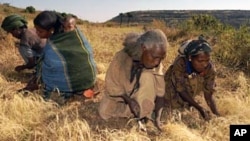It's raining in Ethiopia. After three consecutive years of drought, weather watchers say this year's early season rains are promising. But Ethiopia's farmers are looking forward to a bumper crop that could ease the country's severe food shortage.
Ethiopia's disaster relief agency chief Tadesse Bekele is smiling. He's just come from a staff meeting where field reports suggested conditions are right for one of the best early season harvests in years.
He says good rains nationwide may make it possible to lower the current estimate that 5.2 million Ethiopians will need emergency food assistance in the first six months of this year.
"We have started compiling information from regions, and that showed us there has been a major change on rain availability and we are going to reassess number of people affected. Because this will change the number from 5.2 [million] to some reduced number," he said.
Tadesse emphasized that the so-called 'belg' crop now in the ground is the smaller of Ethiopia's two harvests. The bigger 'meher' crop, which accounts for 80 percent of the country's cereal production, depends on the second rainy season beginning in June.
But he says in a country where one in six of Ethiopians receive some nutrition assistance, the better than expected rain is creating a "drastic change" in the food security outlook.
"We entirely depend on rain. The more we get the rain, the more we get the food. The more we get the food, the less will be the food insecure aspect," said Tadesse.
But this hopeful future contrasts sharply with the present, and the immediate past. Much of east Africa is still suffering the hangover from three bad years.
Farmers say the old pattern of a few good years interrupted by a bad one has been reversed. Recently it's been more bad years than good.
Judith Schuler of the UN World Food Program office reports a critical shortfall in donations, not only for emergency assistance, but also to fund a "food for work" program called the safety net, which helps another 8 million people in regions where malnutrition is a chronic problem.
"We have enough resources for the next few months. However, we have to cover all the needs for the whole six months, and in order to do so, we still need $160 million for the next few months. the total requirements are $390 million, and the shortfall is 41 percent," she said.
Donations are trickling in. The United States remains by far the largest single donor of food aid, more than $500 million last year.
Britain this month announced a $30 million emergency contribution in addition to a $300 million donation earlier this year to help fund the safety net program. British development agency chief in Ethiopia, Howard Taylor, says the money is aimed not only at saving lives, but at ending Ethiopia's dependence on the increasingly erratic rains.
"What we are looking at doing...is also supporting instruments and programs to help Ethiopia move away from the situation where it needs emergency assistance year on year," he said. "So for example the very large Productive Safety Net Program. stops them selling vital assets or pulling children out of school or that sort of thing in order to survive," said Taylor.
Disaster relief agency chief Tadesse acknowledges Ethiopia will need the safety net for the foreseeable future. But for the moment, the blessing farmers are celebrating comes from above.
"Regular rain in majority of the areas. Really, its... Thank God things are being changed, thank God, thank God," Tadesse said.
Aid official Howard Taylor points to evidence that, even counting the recent 3-year drought, conditions are improving. He says 25 years ago, when famine struck, 1 million of Ethiopia's 40 million people died. Today, the population is 80 million, yet malnutrition deaths are a tiny fraction of what they were.
Rains Bring 'Drastic' Change in Ethiopia Food Outlook









